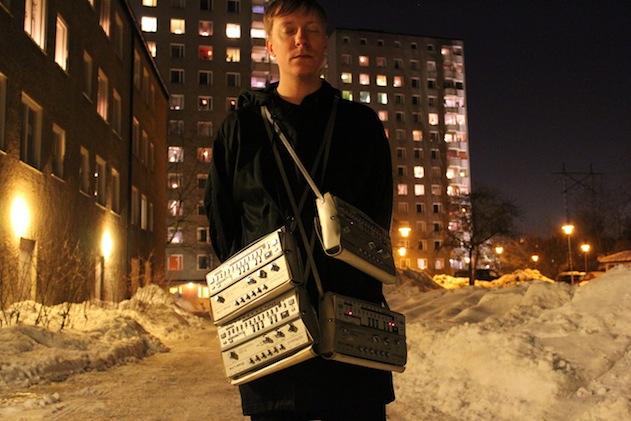Acid techno is transformed into dub-y trance in the masterful hands of TM404, aka Andreas Tilliander, aka Mokira (under Type and Raster-Noton). In a beautiful video released this month, a lineup of blinking Roland boxes becomes simply mesmerizing. It is technically acid techno, yes, but here those rhythms rotate gently in hypnotic harmony.
Not that TM404 can’t also dial his ensemble of analog voices into a dervish-like dancefloor frenzy. That side was on evidence Saturday night in Berlin. Ostensibly, Andreas was there to promote Elektron’s new boxes, as a big Analog Four Keys banner hung behind him, but he might just as well have arrived as a Roland artist endorsement. (Well, as a Roland artist endorsement who came via time machine from the 1980s.)
Here’s an example of what that sounds like. It sounds like acid, complete with the requisite 303 squelch, but adds asymmetrical twists, rendering it in abstract, tribal energy.
As it happens, looking at how Andreas plays answers some of the controversy over the weekend to Elektron’s approach to sampling. In the launch event, Elektron talked about skipping the laptop and using one of their machines as the “studio.” That claim might make more sense with the addition of their OctaTrack, at least, but it raised a larger point (a funny one, given the room at the time was full of laptop-using artists, let alone a number of NI and Ableton employees).
I clarified details of the sequencing functions. Basically, you get sync via MIDI and DIN out, and must use CV/gate for anything else – that is, you can only step-sequence analog gear. But part of the advantage of connecting gear, as seen in this video, is really about using the onboard sequencing, because it externalizes each musical element. The parade of light-up buttons is a little like looking over the shoulder at the notated part of an individual musician in an orchestra. So sync, for many Elektron customers, is probably enough.
That isn’t the way everyone wants to work. But if you do choose to work that way, this isn’t a bad way to go about it. And TM404’s musical imagination can be inspiring, however you play.
This recording is Andreas’ favorite ten minutes from the Insomnia Festival, in Tromsø, Norway in October:
And here’s what happens when he starts mucking about in the studio:
For a more complete set, we can turn to the Musikinstitutet of Goteborg, Sweden, that mythical land of Elektron. This rig was similar to what he brought to the Elektron party, though as far as I know, none of us tried to steal his shoe.
Recorded with two ambience microphones. Unfortunately no line.
45 minutes of unreleased material.Setup that night was:
Elektron Octatrack
Elektron Octatrack
Elektron Machinedrum
Roland TB-303
Roland TR-808
Eventide TimefactorSomebody nicked my shoe during the set. That’s what the fuzz in the end is about.
I had to walk back to the hotel wearing just one shoe.
And in case you missed it last time, here’s his set from last year’s CTM Festival:
For more 303 on 303 on 303 on 303 on 606 action, here’s a video from 2012:
And there’s a great feature on Electronic Explorations:
Shows > TM404
Plus a feature on Attack magazine:
Interviews > ANDREAS TILLIANDER – TM404
Here’s the most important answer he gives – it illustrates that the 303 sequencer encourages musically-motivated, harmonically-defined accidents:
The 303s are impossible to program if you want them to play whatever melody you’ve got in your head. It’s more about deciding what harmony they should play and then you have to program, program, program until you’ve got something you like. The best patterns or melodies happen by accident.
And to the question, “Did you find that the sequencers limited you?”
No, not at all. That was what triggered me. I swear by my 303 sequencers just because you don’t really know what to expect while playing with them. In my studio I’m lucky enough to have the best hardware sequencer – the Sequentix Cirklon – and the best soft sequencer – Ableton Live – and I love composing with those but for the TM404 project it was important to rely on the TB-303.
You can find finished records on Kontra Musik now, at least for the TM404 moniker.
KM029/KMCD04: TM404 [self-titled full-length from early this year]
KM028: TM404 – The Morphosis Korg Response [so you get some MS-20 and SQ-10 from Lebanese-born, Berlin-based Morphosis, to go with your 303 – ebony and ivory, Korg and Roland playing together]
I look forward to more TM404 sounds. Thank you, Andreas – you made my weekend.
